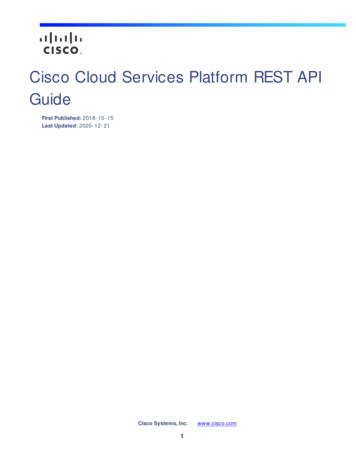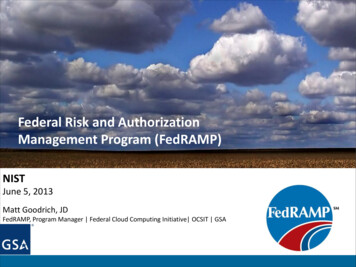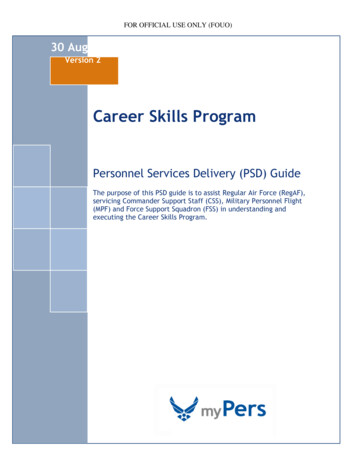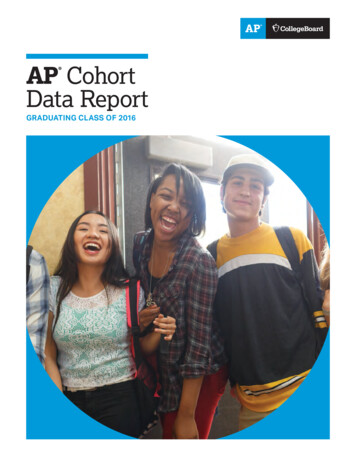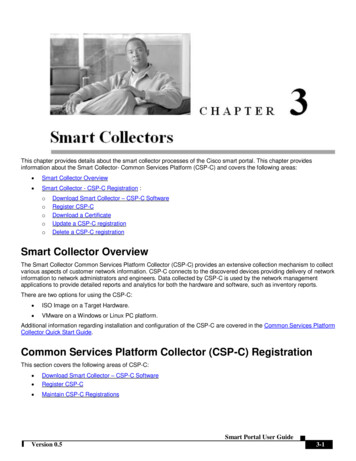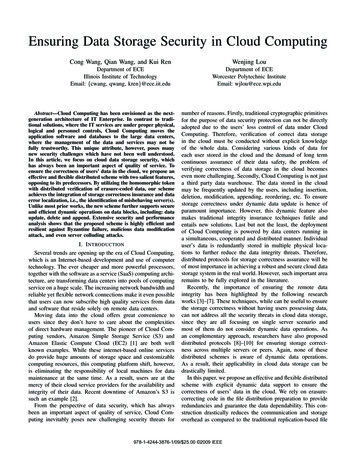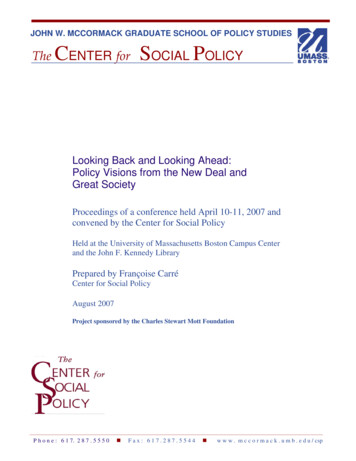
Transcription
JOHN W. MCCORMACK GRADUATE SCHOOL OF POLICY STUDIESTheCENTER for SOCIAL POLICYLooking Back and Looking Ahead:Policy Visions from the New Deal andGreat SocietyProceedings of a conference held April 10-11, 2007 andconvened by the Center for Social PolicyHeld at the University of Massachusetts Boston Campus Centerand the John F. Kennedy LibraryPrepared by Françoise CarréCenter for Social PolicyAugust 2007Project sponsored by the Charles Stewart Mott FoundationP h o n e : 6 1 7. 2 8 7 . 5 5 5 0Fax: 617.287.5544w w w . m c c o r m a c k . u m b . e d u / csp
Looking Back and Looking Ahead: Policy Visions from theNew Deal and Great SocietyTable of ContentsIntroduction. 2Background and goals . 2Acknowledgements. 3Keynote speech – Taylor Branch, Author, “Civil rights and the Great Society”. 5Q&A . 6Panel 1: Historical Context – The New Deal and the Great Society. 7Meg Jacobs, History, MIT, “What was new about the New Deal?”. 7Bruce Schulman, History, Boston University, "Bold, persistent, experimentation: The state and socialpolicy in the New Deal and Great Society." . 9Q&A . 12Panel 2: Socio Economic Issues . 13James Roosevelt, Tufts Health Plan, ”Bringing the New Deal forward: Lessons from a vision of hopeand security.” . 13Senator Harris Wofford, “Big visions and lost opportunities” . 15Michael Piore, Economics, MIT, “Perspective on income distribution.” . 16Q&A . 18Highlights of Discussion Groups Following Panel 2. 19Panel 3: Elementary and Secondary Education Policy- Compensatory Education. 21William Taylor, Citizen’s Commission on Civil Rights, “Arguments for compensatory education: TitleI of the 1965 Elementary and Secondary Education Act” . 21Roger Rice, Multicultural Education, Training and Advocacy, “Title VII (bilingual education) of the1965 Elementary and Secondary Education Act and beyond.". 23Milton Goldberg, Education Consultant, “The Evolution of education policy “ . 24Q&A . 25Highlights of Discussion Groups Following Panel 3. 27Conclusion . 29Further Information and Resources. 292007 by the J. W. McCormack Graduate School of Policy Studies, UMB1
IntroductionOn April 10 and 11, 2007, the Center for Social Policy convened a conference exploring policyvisions from the New Deal and Great Society and their implications for today’s policy thinking.Titled, "Looking Back and Looking Ahead", this conference took place at the University ofMassachusetts Boston Campus Center and the John F. Kennedy Library.The conference was designed as an opportunity for speakers and participants to reflect on thelessons learned from these two watershed eras of policy innovation and their implications forlooking forward. Policy actors and experts participated in three panel discussions on the historicalcontext of the two eras, socio-economic issues and policy of the times, and arguments forcompensatory education policy. Each of the three panels was moderated by a facilitator.Following is a summary of the proceedings: the talks by the policy actors and experts; theirresponses and comments to the question and answer sessions, and the learning conversationsamong conference participants that took place in the breakout sessions following featured paneldiscussions.Presenters and participants were drawn from the fields of social policy, education policy, andhistory . They included former policy actors, representatives of civil society organizations(advocacy, public information, associations of public officials) and philanthropy, academics, andexpert consultants.The agenda, list of participants, list of readings, speaker biographies, and videos of introductions,speeches, panel presentations, and concluding remarks are available on the conference websiteat: ngahead/index.phpBackground and goalsThis conference project came from a desire for renewed inspiration in policy work and fromconversations with the Pathways out of Poverty program officers at the C. S. Mott Foundation.Those involved in social policy advocacy and philanthropy find it increasingly difficult to argue thathelping people who experience poverty and are economically vulnerable is good for society as awhole, and not only for those helped. In other words, it is difficult to convey that we, as a society,may choose to assist others and to redistribute resources because we wish to shape the natureof the society and its economy in ways that reflect a commitment to social justice. It has becomechallenging to hold up this simple and well known vision in the public eye and in policy debates.This conference project aimed to learn from earlier policy eras during which advocates and policymakers articulated a broad vision for society and a clear role for government, as well as for socialapproaches rather than purely individual solutions. Policy actors of the New Deal and GreatSociety moved toward systemic change because it was needed, and social justice had to bedelivered. Times were difficult. Policy actors came to the realization that a broad societal projectwas necessary. This project and conference aimed to learn from these two policy eras how tobetter make visible the interdependence of social and economic life.In both eras, policy actors came to the realization of the need for change because of objectiveconditions—hunger, economic upheaval and displacement—but also because of the pressurefrom social forces and social movements. For the New Deal, it was labor and social unrest aswell as the farm crisis. For the Great Society, it was the Freedom Rides and the subsequentmovement for civil rights but also the urban riots and the “rediscovery” of multiple forms ofpoverty.2
The primary goal for the conference was pragmatic; it was simply for participants to draw from thepast what they need in order to better move forward with their respective policy agendas in socialpolicy and education policy—what we termed “looking back while looking ahead.” It was to usean exploration of the past in order to understand how policy arguments were constructed toconvey a broad vision for society, one that recognizes the interdependence of American life andacknowledges social justice as an explicit goal.Participants and presenters were asked to engage in this exploration with their eyes open. Policyefforts in both eras, particularly those of the early New Deal, reflected tensions and politics oftheir time. De facto, and sometimes by design, racial-ethnic groups—at the time primarilyAfrican-Americans, Chicanos, and Asian-Americans— were excluded from the reach of keypolicies and often invisible in policy debates. Probably the best known case was the exclusionfrom Social Security old age pension of agricultural and domestic workers, a policy design whichde facto excluded the overwhelming majority of African-Americans and many Chicanos fromcoverage and left a broad swath of the Southern population uncovered.Each of the two policy eras had a distinctive approach. The New Deal era was unique in that itexplicitly addressed multiple facets of economic life, regulating the capital markets, addressingthe labor exchange in the workplace, and making the redistribution of income an explicit goal.The Great Society policies were motivated by calls to deliver on the un-fulfilled promise ofuniversality of the New Deal apparatus, including minorities in the policies and programs initiatedthen. The era’s hallmarks are equal access policies.We noted that the current social and economic context is different in meaningful ways from thoseof these two early eras. Most notable are the high level of immigration the country hasexperienced in the past 15 years and the transnational organization of production andconsumption. For all participants, the challenge lay in moving from insights from early eras to thecurrent context. All were asked during the two-days to take what was learned and refashionarguments they make in their respective work context. They were asked: how might you cast thevision you wish to convey in your policy arena?In essence, participants were asked to focus on the goals and policy legacies of those eras, whathas become “part of the woodwork”, while acknowledging their limitations, the most salient ofwhich entailed racial and social exclusions. This document summarizes presentations as well asfruitful debates and small group discussions.AcknowledgementsThis project benefited from the insights and work of many individuals. We are very grateful to allof them. At the C. S. Mott Foundation, An-Me Chung and Neal Hegarty of the Pathways Out ofPoverty program provided suggestions and feedback throughout the planning process. Thegenerous support of the Foundation made possible this project and conference.Of course, we thank the speakers and panelists whose thoughts and enthusiasm informed,challenged, and encouraged the audience to think broadly and deeply. And we thank allparticipants for bringing their questions and concerns to the meeting.Several individuals served as advisors to the project. They are: Prof. Randy Albelda, Prof.James Green, Prof. Edmund Gordon, Dr. Milton Goldberg, Prof. Daniel Horowitz, Prof. SanfordJacoby, Hubie Jones, Delia Pompa, and Sen. Harris Wofford. Of course, responsibility for anyshortcoming is all ours.3
At Center for Social Policy, the project team included: Dr. Françoise Carré, Sheila D’Alessandro,Abby Elmore, John McGah, Ann Robbart, Aimee Soulios, and Elaine Werby. We also thankDean Steve Crosby and Dr. Michael Collins, Chancellor, for their remarks.A team of facilitators focused conversations during small group meetings. They included: Dr.James Callahan Jr., Dr. Murray Frank, Prof. James Jennings, Rudolph Kass, Bill Nigreen, Prof.Maureen Scully, Prof. Paul Watanabe, and Martella Wilson-Taylor.Several individuals took the notes that form the record of group discussions. They are: Rosa DeLa Cruz, Coleen Goodrich, Dr. Erika Kates, John McGah, Dr. Tatjana Meschede, PatriciaPeterson, Jack Reynolds, Julia Tripp, and Elaine Werby.4
Keynote speech – Taylor Branch, Author, “Civil rights and theGreat Society”Taylor Branch begins with describing the times around the New Deal and, later, the Civil Rightsmovement and Great Society as times when the world was “fundamentally out of whack”. Themodels that emerged from those eras to go about “refining, pursuing, protecting, and advancing”American democracy at home and in the world are not those that are followed today. Nowadays,the world is “out of whack” again but the country’s policy is to follow a “Vietnam model” (spreadingdemocracy through military action). People in the Civil Rights movement were “geniuses of thestreet and of the mind” who aimed to change the country’s political outlook and achieve“miracles”. They worked through a mass movement of people to whom the word “policy” was aforeign word; it was not part of the movement’s natural vocabulary. Nowadays, as it was then, toadvance democracy and “rectify the world out of whack,” a key challenge is to find a way toconnect the world of social movements with the world of policy analysis, in order to make bothhealthier and stronger. That melding did take place during the New Deal and Great Society eras.Branch offers personal reflections upon the “radioactive” race divisions in the 1940’s South andthe riveting as well as transformative impact on his childhood and youth of the Civil Rightsmarches, voter registration drives, and nonviolent direct action means of the movement. Branchwrote a story-telling history of civil rights activists and actions to resist what he sees as mythmaking in public discourse about the movement. People from the movement struggled with themeaning of equal citizenship and “equal souls,“ and how the two concepts are related. In so doingtheir struggle and redefinitions of these two concepts fundamentally changed the South andnational politics, drastically altering opportunities for all in society, not only Southern blacks.“Miracles came out of that era” for women, for immigrants (Immigration reform in 1965), and otherpeople in subordinate social positions.Historical story telling is a key means to avoid myth making. “I believe that stories that are humanenough to resist mythology are necessary here because, in our history in the United States, wehave a very sad tale of how myths, and how people need to believe what they want to believe,can subvert even the most powerful forms of history. And I think that’s related to the reason whythe New Deal and the Great Society are not even today great upstanding models of public policyon everyone’s lips.” The movement took American democratic principles seriously, gave them lifein the movement, and these same principles have been espoused in other parts of the world, areminder to the US of the concrete life of its founding values.What got lost in mythology about America’s founding, the New Deal, and the Civil Rights andGreat Society eras are, among others, the following notions: the key role of government inaffirming and making real the founding democratic principles of the country; the notion of publicservice; and the key responsibility of movements to compel the government to act on theseprinciples. Pundits and others who interpreted the public legacy of the social movements of theGreat Depression and the Civil Rights movement folded them in with the multifaceted socialprotest at the time of the Vietnam War. In so doing, they debased/denigrated the know-how ofnonviolent direct action, the demands and expectations that these movements placed on thenation to uphold the true meaning of democracy, and minimized their tremendous legacy ineveryone’s life.“Nobody is more disciplined than a freedom rider and more disciplined in classical, democraticarchetypes that James Madison said are ‘new in the world.’ That people can govern themselves,that they can be self governing, they can discipline themselves individually and collectively, andthey can do it while cultivating a sense of public trust. The Freedom Rider says, ‘you can beat mebut I’m going to establish a new relationship coming out of that that will make both you and mebetter off because I refuse to demonize you.’ Tremendous discipline, tremendous sense of publictrust, and a tremendous tragedy that we’ve allowed that era to be denigrated by mythology Idon’t blame the people who did it. Most of the people who continued to be the pundits and the5
interpreters of the era of the 1960’s were confused by Vietnam; they were outside the Civil Rightsmovement. It took place in another world, and yet they had to be the experts and the interpretersof what had happened. So they, like the interpreters of the civil war and reconstruction, createdall theses myths that made them feel comfortable.”Branch reminds us of how social movements acted on democratic principles and laid claim to aconstructive role for government.“The people in the New Deal and the people in the Civil Rights era were modern “Founders”. Justlike the Founders, they were confronting systems of hierarchy, they were confronting verticalpolitics, they were confronting subjugation, and they were figuring out ways to transform it tohorizontal politics of self-government that bind us together and create enormous strength out ofthat.”Branch closes with a call to revive these understandings and come to grips with the full meaningof the legacies of social movements —rather than the myths about them— in order to moveforward.“And they (civil rights actors) proved to have this power that went all around the world, and wehave to revive it. I think that there is an enormous range of intellectual questions that need to beraised, of political questions that need to be raised, but [also] a historical urgency not to let thisdisjuncture between the miracles that were set in motion in those eras, that so many of you wereleaders in, be lost or be denigrated. Not because of what it’s going to do for history, but what it’sgoing to do for our future. In my view, these eras, the New Deal era, the Civil Rights era, are ourfuture if we are going to recover the capacity to adapt, to define and defend our way of life in theworld. That’s the only story America has. If we don’t [do it], we’ll lose it. We’ll lose ourdistinctiveness and we’ve got a lot of work to do to regain the momentum.”In closing Branch reminds the audience that the Civil Rights movement actors “had thisindescribable courage to lift the rest of us toward the true meaning of our own values.”The full text of Mr. Branch’s remarks and his biography can be found okingahead/index.phpQ&AIn answer to a question about what movement might “take on” privilege on behalf of those who“need a hand”: The labor movement can still be a good model because it is based in social class,isjob based, and deals with economics. Issues like dysfunctional schooling or the environmenthave the power to mobilize people. It is unclear yet from where the issue will come around whichmultiple constituencies can coalesce. Branch identifies one group of actors as key.“. I would like to see the people (in) that proliferation of non-governmental organizations,public interest groups, be recognized for what they are, which is people who are in politics. I thinkone of the side effects of the denigration of public service is that those people to some degreehave pretended that they weren’t doing something that 30 or 40 years ago would be politicalorganizing, political agitation. They are part of the political process, and I think that it’s reallygood, and they need to raise up the notion of citizen and public service again.”Thankfully, he observes, the distrust of government and the politics of denigrating anygovernment role might have run their course.In response to a comment suggesting to revive the “other side” of civil disobedience and nonviolent direct action —which is constructive service and social invention—a direction which M. L.6
King also valued, Branch agreed. The constructive side of protest also is connected to theconstructive side of citizenship. He reports a movement leader, Diane Nash, said ‘if you reallybelieve. .you have to design constructive ways to help people grow.’ The Civil Rights movementhad that in common with Gandhi.Panel 1:SocietyHistorical Context – The New Deal and the GreatThe videos of these panel presentations and biographies of speakers can be found okingahead/index.phpProfessor James Green, the moderator, remarked that historians would like to be in dialogue withthe world of public policy and public politics. He offered introductory thoughts stemming from hispersonal and professional experience with the ideas and politics of the Depression, the New Dealand the Great Society. “.I cast my first presidential vote for Lyndon B. Johnson in 1964 believingthat the national government would create a second New Deal I was an intern in the U.S.Senate for Senator Paul Douglas of Illinois who was a shaper of Great Society legislation. . Iworked on the Immigration Reform Act Of 1965 I think it’s one of the most forgotten andimportant pieces of legislation in the 60’s and a real legacy of the Civil Rights movement.”Green’s study of the politics of upheaval and the study of social movements have led him toconclude that democratic struggles and popular forces have exerted extraordinary influence onthe state, particularly during the Great Depression. The questions put to the panelists by theconference organizer are: What lessons can we take from these two periods in our past abouthow the terms of public policy debate shifted so dramatically? So dramatically that endingpoverty, and achieving greater social and racial equality, became national policy objectives.Meg Jacobs, History, MIT, “What was new about the New Deal?”Professor Jacobs started off by reading a letter from a woman to Eleanor Roosevelt written inJanuary, 1935. This woman is pregnant. She has other small children at home, one of whom isfairly sick. And she has a husband who cannot get regular employment. And she writes to Mrs.Roosevelt:“Please Mrs. Roosevelt I do not want charity, only a chance from someone who will trust me untilwe can get enough money to repay the amount spent for things I need. As proof that I am reallysincere I am sending you two of my dearest possession to keep as security. A ring my husbandgave me before we were married and a ring my mother used to wear.”(The writer goes on to explain her life circumstances and says): “Somehow we must manage butwithout charity.” She’s asking for the layette for the baby she’s expecting.“Here’s is a list of what I need but I will need it very soon. If you would get these for me I wouldrather no one knew about it. I promise to repay the cost of the layette as soon as possible. Wewill all be very grateful to you and I will be more than happy.”Jacobs is struck by the “act of faith” of sending one’s valuable possessions to Washington. Thisletter illustrates three of the key notions that are essentially new in American public life with theNew Deal. The first is the notion of economic redistribution—not simply charity but a broadredistribution from the haves to the have-nots. The second is the sense of political mobilization, areaching out by the citizenry to government, a broader awakening that was motivated by the NewDeal. The third new notion was a new sense of the legitimacy of government, a new moral andethical sensibility that government had a fundamental responsibility to its citizenry.7
First, regarding economic re-distribution, the notion was that income inequality of the kindexperienced in the Gilded age and with the Depression was “not just irresponsible or immoral butfundamentally a bad and harmful economic idea and fundamentally corrosive to society at large.”What was new was the notion that laborers were not only producers but also consumers onwhom the market depended. The New Deal policies reflected the realization that “a marketexisted as long as people could afford to buy the goods.” Under-consumption was newlyaccepted as an explanation for economic crises and gained broader acceptance in themanagement press as well as among labor unions. Jacobs argues that the Wagner Act whichestablished ground rules for union representation and collective bargaining was not only aboutworker rights but also reflected this new belief in the need to ensure worker purchasing powerand ensure the country against deep inequality and under-consumption crises. She quotes theWagner Act: “When employees are denied the freedom to act in concert even when they desireto do so they cannot participate in our national endeavor to coordinate production and purchasingpower. The consequences are already visible in the widening gap between wages and profits. Ifthese consequences are allowed to produce their full harvest, the whole country will suffer from anew economic decline.” The New Deal defines the government role as having a fundamental sayabout the distribution of national income between wages and profits. The same language ofpurchasing power is written into the Social Security Act. Income distribution was a legitimatecomponent of public policy. Jacobs observes that economists, politicians, businessmen andlabor leaders had a broader political sensibility to the importance of redistribution, beyond talkingabout the adequacy of purchasing power. They were animated by the notion that everyone had afundamental right to a basic standard of living.Second, the level of political mobilization was new and unprecedented. Letters poured intoWashington with expectations of their government and came from all segments of society: “Fromblack farmers, to middle class people who had never experienced unemployment before, toimmigrant laborers, to desperate housewives.” These reflected a new connection to government.This radical transformation, this mobilization from below was “stoked from on high,” by FDR’scommunications to the citizenry. Within a week of FDR’s first inauguration, 450,000 letterspoured in to the White House and then the rate remained 5,000 to 8,000 per week thereafter.Jacobs argues that this kind and level of political mobilization— from writing letters to newexpectations of government provision to labor activism to voting — was new and a result of theNew Deal. Roosevelt’s public statements in support of the right to organize had great impact.The New Deal also was a moment of major political realignment with the forming of the New DealDemocratic Party, made up of liberals, intellectuals, second generation immigrants which wouldremain a backbone of democratic support and African Americans who had traditionally been inthe Party of Lincoln (by 1936, 70% of African Americans voted for FDR).Third, the New Deal ushered in a new notion of government, a sense that government had astake and a responsibility to maintain and guarantee the well-being of its citizens and this wasembodied in the notion of social security. Not just the Social Security Act, but the phrase socialsecurity, which gained broader acceptance. In a 1934 message to Congress, Rooseveltexplained that the world of close knit communities that romanticizes the images of self-reliant andhardy Americans on the frontier no longer existed. He explained “the complexities of greatcommunities and of organized industry make less real these simple means of security. Therefore,we are compelled to employ the active interest of the nation as a whole through government inorder to encourage a greater security for each individual who composes it.” In so doing, hereferred to, and tapped into, the legacies of the founders of the nation and of major politicians. Tolegitimate what he knew were dramatic claims, FDR invoked a declaration of the most famousRepublican president, Abraham Lincoln when Lincoln said “The legitimate object of government isto do for a community of people whatever they need to have done but cannot do at all, or cannotdo so well for themselves in their separate individual capacities.” Notwithstanding these appealsto historical antecedents, Jacobs argues, the New Deal’s vision represented a bold departurefrom the past.8
This notion of security, of government being given the task to provide security, was expressed byRoosevelt in what he called the Economic Bill of Rights proclaimed in his State of the Unionmessage in 1944. At that time, FDR was imagining what politics and what the New Deal shouldlook like moving forward when World War II comes to an end. In the speech, he lays out a secondBill of Rights, a Bill of Economic Rights which includes “the right to a useful job, the right to earnenough to provide adequate food and clothing, the right of every farmer to raise and sell hisproducts, the right of every businessman to trade freely, the right of every family to a decenthome, the right to adequate medical care and the opportunity to achieve and enjoy good health,the right to adequate protection from the economic fears of old age, sickness, accident andunemployment and the right to a good education.” And then he says “All these rights spellsecurity.” The conclusion to this speech captures a certain kind of hopefulness about the rolegovernment could play in American life and one that still resonates, or ought to resonate today.He says “After this war is won we must be prepared to move forward in the implementation ofthese rights to new goals of human happiness and well-being. American’s own rightful place inthe world depends on a large part upon how fully these and similar rights have been carried intopractice for our citizens. For, unless there is security here at home, there cannot be lasting peacein the world.”Bruce Schulman, History, Boston University, "Bold, persistent,experimentation: The state and social policy in the New Deal and GreatSociety."Professor Schulman began by sketching some of the ma
Maureen Scully, Prof. Paul Watanabe, and Martella Wilson-Taylor. Several individuals took the notes that form the record of group discussions. They are: Rosa De La Cruz, Coleen Goodrich, Dr. Erika Kates, John McGah, Dr. Tatjana Meschede, Patricia Peterson, Jack Reynolds, Julia Tripp, and Elaine Werby. 4


